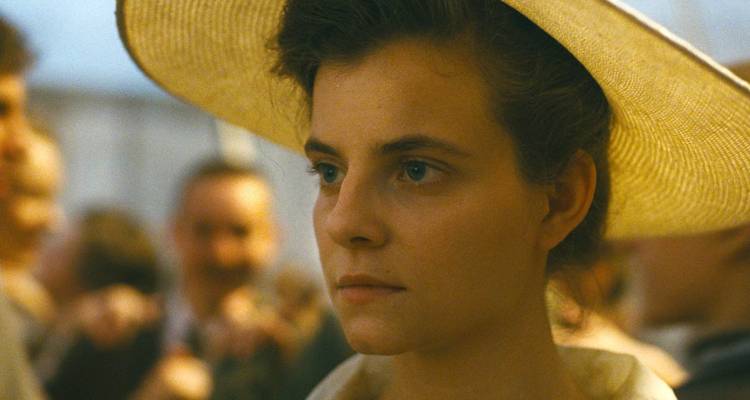In 2015, director László Nemes stunned moviegoers away with his harrowing, Oscar-winning directorial debut, “Son of Saul.” For his follow-up movie, the 41-year-old Hungarian returns with his new feature, “Sunset,” which examines the frayed tensions in Budapest during the lead-up to World War I. And if it’s not broken, don’t fix it: the director revisits the now-signature, immersive point-of-view camerawork style to craft a cryptic drama featuring chilly characters and decadent production design. It’s an ambition film, but one that doesn’t always work.
READ MORE: 55 Must-See Films: The 2018 Fall Movie Preview
It’s 1913, and young and hungry Írisz (Juli Jakab) arrives in Budapest with her hopes set on working in the renowned Leiter hat store. Her dreams are soon dashed by the shop’s new owner, Oszkár Brill (Vlad Ivanov), who notices something about Írisz, becomes cold, and refuses to hire her. But Írisz won’t give up. The Leiter hat store belonged to her parents who died in a fire when she was a baby, and working there offers her a connection to her family. She eventually gets the job and learns that she has a brother somewhere out in the city. Írisz’s dogged pursuit of answers takes her through the darkest and most dangerous corners of an unraveling society.
READ MORE: Toronto International Film Festival: 22 Most Anticipated Movies
“Sunset” has a distinct visual style that sets it apart from most films. Despite the picture’s elaborate costumes and production design, the camera is stingy with its gaze. There are no sweeping establishing shots, and the focus remains mostly super focused and tight, in front of or behind Írisz. The film often looks like a FaceTime video, locked in around shoulder height, even when she’s moving amidst a shot. Nemes’ camera often swirls around to pick up a scene’s critical details before slinging back behind Írisz shoulders and this technique frustrates after a while.
Nemes prefers to capture long tracking shots, and the camera’s limited view often creates a tunnel vision type of vibe, especially in poorly lit scenes. A good deal of the action is captured with a shallow depth of feel which blurs out everything onscreen not in Írisz’s immediate vicinity. It has a dreamlike effect, and it’s also as close as you can get to sharing her perspective outside of a first-person shot. Cinematographer Mátyás Erdély jumps through many technical hoops to make the camera move so seamlessly, but it’s not the most visually dynamic approach. This confined viewpoint sucks some life from the movie, and it’s understandable if people find “Sunset” too dull. Alternatively, when the action picks up, the confined perspective becomes menacing as threats remain undetectable until they’re right on top of Írisz.
READ MORE: 9 Must-See Premieres At The 2018 Telluride Film Festival
“Sunset” evokes memories of one of 2017’s most hotly-debated pictures, “Mother!” by Darren Aronofsky. The super-tight camera work is the most obvious comparison, and both films also prioritize atmosphere and theme over a coherent story. “Sunset” prefers to elicit strong feelings in the moment rather than make sense. This means exposition and character building take a back seat. And as great as Jakab is in her role, she doesn’t offer much range of emotion — and that’s excluding the large chunk of the film that is shot from behind her head. It’s left up to viewers to fill in the connective tissue that binds the story’s most dramatic moments, which is no easy feat.
READ MORE: Steve McQueen’s ‘Widows’ Is A Stylish Thriller Starring Viola Davis [TIFF Review]
Costume designer Györgyi Szakács and production designer László Rajk turn in exquisite contributions to this picture. Their stunning work even steals a few scenes away from the film’s talented cast. Intricately embroidered dresses and the Leiter shop’s ostentatious hats lend the characters a sense of nobility. And every table, chair, and teacup in this considered world feel deeply authentic. Erdély captures many interior shots under soft lighting that casts a warm, inviting glow over scenes. When Írisz steps outside, Budapest’s bustling streets feel as densely packed and chaotic as modern-day Manhattan and the exterior color palette’s bleak, blown-out whites add to the sense of anarchy. Nemes painstakingly crafts a world that is a romanticized portrait of the past that is on fire around its edges.
Laśzló Nemes’ ‘Sunset’: 3 New Clips Point To More Longtakes & Another Immersive Cinematic Experience
Ultimately, the chilly “Sunset” recreates a version of 1913 Budapest that crackles with life but lacks spirit and emotional connection. Nemes shows viewers the smoke and then the fire but provides no reason for them to care about the world as it burns. His cold and detached style becomes numbing long before the credits roll, and the picture’s explosive final moments turn into one long monotonous drone. Jakab’s strong, restrained performance isn’t enough to keep the audience tuned in for the entire 142-minute running time either. Nemes’ promising talent is never in question, however “Sunset” is handcuffed by his reliance on point-of-view camerawork, a trick that backfires and ends up holding the audience hostage instead. [C+]
Check out all our coverage from the 2018 Toronto International Film Festival here.

